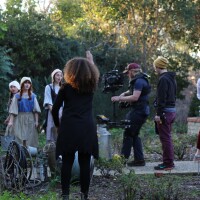Alcatraz Island: A History of 'The Rock' On-Screen

Vireo, the groundbreaking made-for-TV opera, is now available for streaming. Watch the 12 full episodes and dive into the world of Vireo through librettos, essays and production notes. Find more bonus content on KCET.org and LinkTV.org.
As a major tourist attraction, more than a million people visit Alcatraz Island each year to see the old haunts of Al Capone, Machine Gun Kelly and Robert Stroud, the Birdman of Alcatraz. But for much of its inhabited life, The Rock, as it’s been known since the 1890s, was a place that most people wanted to avoid.
During a Spanish mapping expedition in 1775, Alcatraz was named Isla de los Alcatraces, Island of the Pelicans, due to its habitation by the birds. When the Americans came and declared California a state, the government claimed the island as a military post because of its central location in San Francisco Bay. Construction of a massive brick fort on the sandstone island began in 1853 and it was finally completed in 1859.

From the beginning there was a prison on the island. Its solitary location made it a natural candidate for military prisoners coming from Fort Point and the Presidio in San Francisco. By the late 1800s there was an average of 100 men incarcerated on the island. It was officially designated a military prison in 1907. The confined population continued to grow, and a new building with 600 cells was constructed. A power plant to produce electricity and steam heat was built, but the main problem with the location was that food and water had to be shipped in from the mainland. In 1933, the military handed the island over to the Federal Bureau of Prisons and Alcatraz entered its most notorious period of occupation. Billed as escape-proof, some of the worst criminals in the system were sent there to serve time when it reopened as a federal prison in 1934.
Through all its years as a high-security facility, access was limited, and even photographs within its borders were rarely permitted.
Through all its years as a high-security facility, access was limited, and even photographs within its borders were rarely permitted. Like the view of the island seen by residents of San Francisco and its surrounding cities, most photographs of Alcatraz were taken at a distance, offering little information about what was inside. When motion pictures were invented, they faced the same barrier, the military would not grant anyone access, and neither would the Bureau of Prisons. In the 1930s, with Hollywood’s fascination for gangsters, Warner Brothers broke the ice in setting a movie within its walls for the B movie “Alcatraz Island” (1937), but the only real views of The Rock were from the air, and everything else was a set in Burbank. That trend continued along the same lines with “Passport to Alcatraz” (1940), “Seven Miles to Alcatraz” (1942), “Road to Alcatraz” (1945), “Train to Alcatraz” (1948) and “Experiment Alcatraz” (1950).

In 1962 the low-budget barrier in depicting Alcatraz was broken with the release of “Birdman of Alcatraz” starring Burt Lancaster in the title role. Lancaster and co-star Karl Malden came to San Francisco in January 1961 for three days of exterior shooting, although Prison warden Paul Madigan promised “no cooperation whatever” and the director of federal prisons actively tried to suppress the film. When the crew was out in the bay to shoot they weren’t allowed to get any closer to the island than 200 yards.
The critical success of “Birdman of Alcatraz” marked the beginning of a change in Hollywood’s association with Alcatraz, which was made possible after the prison closed down in 1963. The closure forced the government to open the gates of the facility to outside interests because there was a need to bring in money to pay for the island’s upkeep. When Metro-Goldwyn-Mayer approached the General Services Administration, now in charge of the island, to film there, the G.S.A. approved it, for a rental of $2,000 a day. The first movie to actually film on its grounds was “Point Blank” (1967) starring Lee Marvin, and in March 1967 the company’s cast and crew of more than 100 invaded the island. It was a major effort to film there. The movie’s producer, Judd Bernard, said, “We have to provide our own electric power, trucks, cars, drinking water, furniture, toilets, and because the prison was heated by steam, we have to provide butane heaters for the cell blocks.” The actors and technicians also had to be transported daily from San Francisco by a fleet of boats. While filming one night, Lee Marvin wrote a note that read, “Help! Am lost on Alcatraz.” He stuffed the note in a bottle and threw it into the ocean. Someone found the bottle washed up on the beach north of San Francisco at Bolinas. It was a grim reminder of what the swift currents of the Bay could do to any escaped convict from the island.

The steep price tag for using the island brought a period of abandonment to the island, until American Indians occupied it in November 1969, claiming The Rock as their own. They found it no more habitable than previous tenants, and with some difficult times struggling to live there, they left peacefully in June 1971.
The second time a movie crew used the island was for a television show, “The Streets of San Francisco,” in an episode entitled “Going Home,” made in 1973. It was the first film under the control of the National Park Service, which still maintains it to this day. Karl Malden and Michael Douglas spent the day there, in a shootout sequence with mobsters. Douglas commented in a San Francisco Chronicle interview, “At first this place is fascinating. A filmmaker’s paradise, if you’re looking for atmosphere. Then it becomes depressing when you think about it. Especially when you contrast the island to its surrounding beauty.”
Clint Eastwood was there for atmosphere in the fall of 1976 for the third Dirty Harry film, “The Enforcer.” Two years later Eastwood was back, for “Escape from Alcatraz,” about the dramatic attempt by three prisoners to do just that. Paramount Pictures spent a fortune to make the rundown facility look fresh, painting, buffing and refurbishing Cell Block B. Just the wiring and lighting cost $60,000. But the month and a half of filming on location paid off, producing a taunt thriller skillfully directed by Don Siegel.
The next major film on the island was “Murder in the First” (1995) with Kevin Bacon, Christian Slater and Gary Oldman. Jim Quillen, a former Alcatraz inmate, and Frank Heaney, a former prison guard, were consultants on the film; they questioned the accuracy of much of it. Heaney called it “pretty far-fetched.” In the film, Bacon spends three years in a dungeon below Cell Block A. Heaney said, “They never put a guy in there for more than seven days as far as I know.” Marc Rocco, the director, had more than 300 people working for him in the cramped quarters. He claimed, “The place has a way of wearing you down,” not the least of which is the weather, that “freezes your buns off.” The hardships were compounded because the National Park Service didn’t want to impede the flow of tourists, so the film was shot mainly at night.
Filmmaking went from improbability to fantasy with “The Rock” (1996), starring Sean Connery, Nicolas Cage, and Ed Harris as a renegade marine general threatening to launch a nerve gas attack from Alcatraz to San Francisco if his demands are not met. It’s up to Connery and Cage to stop him. The tagline for the movie is: “Alcatraz. Only one man has ever broken out. Now five million lives depend on two men breaking in.”

Several documentaries have been filmed on the island over the years –a portion of the episodic made-for-television opera “Vireo: The Spiritual Biography of a Witch’s Accuser” was even filmed here – and filmmakers continue to find its forbidding landscape ideal for the big screen. Apocalyptic movies like “X-Men: The Last Stand” (2006) and “The Book of Eli” (2010) used the island at least in part. As more areas on the island become rehabilitated, there’s no doubt movies will continue to be made on The Rock, for there are still many secrets left to unlock.
Top Image: Filming of "Vireo" in Alcatraz | John Spiak


